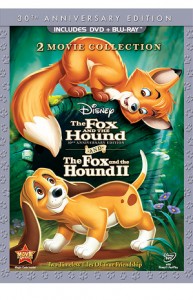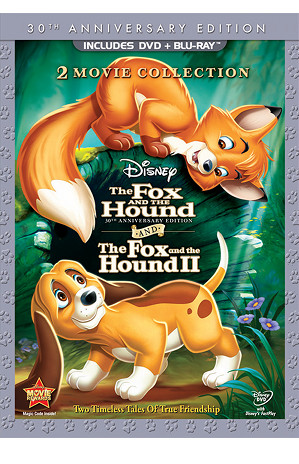
Thanks to fellow Mouseforless blogger Michelle Beck for suggesting this film!
The 24th full-length animated feature in Disney history, The Fox and the Hound was released on July 10, 1981. It is based on Daniel P. Mannix’s 1967 novel of the same name and is 83 minutes in length. A 69-minute midquel, The Fox and the Hound 2, was released directly to DVD on December 12, 2006.
Plot Summary
A mother fox is killed by a hunter, Amos, leaving her kit without a caretaker. It’s a sad situation for sure, but things quickly brighten. A lonely old lady, Widow Tweed, takes in the baby fox, which she names Tod, and the kit finds a great friend in Amos’ new hound, Copper.
Tod and Copper engage in various pastimes together, including swimming and sniffing around—they are animals after all—and they appear to be having the time of their lives.
Unfortunately, the friendship between the fox and the hound is threatened by a natural question. Can Copper remain amicable with a critter that should be his prey?
Themes
The film is centered on the theme of friendship. What makes a good friend? Are certain types of creatures just not meant to be friends with one another? These questions are explored through the evolving relationship between Tod and Copper.
The film suggests that the best way to make friends is to be yourself. If you take this advice, everything else will rightly fall into place. Tod discovered the importance of sincerity when he nearly blew his relationship with a female fox named Vixey by pretending to be an expert at catching fish.
Villains
The theme of friendship is more significant to the film than the individual players are. The characters in The Fox and the Hound aren’t well developed, and the moralities of their respective goals are largely open to audience interpretation. In other words, there is no true “bad guy” here.
While Amos is the film’s antagonist by default in that he opposes Tod and illegally sneaks into a “no hunting” zone in an attempt to catch him, the man doesn’t seem to be hated by the other characters. Indeed, Amos manages some support: Copper willingly hunts for him, and even Widow Tweed respects his right to maintain his chosen lifestyle. This situation stands in contrast to other Disney flicks where villains such as the Evil Queen from Snow White and the Seven Dwarfs (1937) or Frollo from The Hunchback of Notre Dame (1996) are almost universally opposed.
Amos’ original hunting dog, Chief, also has a conflicting personality. He’s an egomaniac and wants to be the center of attention, but he loves Copper and vice versa. When viewing his facial expression before he goes to sleep towards the beginning of the film, I got the sense that Chief is glad that Copper is now part of his life.
Humor
The Fox and the Hound takes a serious tone, but several scenes are included for comic relief, and Dinky and Boomer, a sparrow and a woodpecker, respectively, are featured almost entirely for laughs. Among other activities, these birds attempt to catch Squeaks the caterpillar using both their mouths and their literally electrifying personalities.
Music
In contrast to both the early Disney films and those produced during the animation renaissance of the 1990s, music isn’t a focal point in The Fox and the Hound. The limited music here does a solid job of augmenting the film proper, but I don’t think it’s among Disney’s best soundtracks in that I wouldn’t seek the songs out otherwise.
Still, the various tunes work well in the film. Coupled with the sights of Tod and Copper playing together through the ups and downs of life, the song “Best of Friends” transported me back to my childhood. It’s a surprisingly powerful sensation albeit a somewhat depressing one. Why do we have to grow up? Why couldn’t Neverland be real? Oh well; that’s life, I guess.
Relationship to Other Disney Films
The scenario of Widow Tweed serving as a parent to a different type of creature is duplicated in other Disney works. For example, Lambert the Lion from the 1952 short Lambert the Sheepish Lion is raised by a flock of sheep. Also, in Tarzan (1999), the human title character is brought up by a gorilla named Kala.
Aside from plot similarities, several of the voice actors from The Fox and the Hound prominently appeared in other Disney productions. For example, Copper was played by Kurt Russell, and Pat Buttram voiced Chief. Russell has starred in many Disney films throughout the years, including all three installments of the Medfield College trilogy—The Computer Wore Tennis Shoes (1969), Now You See Him, Now You Don’t (1972), and The Strongest Man in the World (1975)—and, more recently, Miracle (2004). As for Buttram, he appeared in The Aristocats (1970) as Napoleon the dog, in Robin Hood (1973) as the Sheriff of Nottingham, and in The Rescuers (1977) as Luke the Mouse.
Additionally, the voice of the friendly porcupine, John Fiedler, regularly played Winnie the Pooh’s Piglet until the actor passed away in 2005.
In the Parks
No attractions or regular character meets based on The Fox and the Hound are currently featured at Walt Disney World or Disneyland.
Overall
The Fox and the Hound isn’t Disney’s most developed film, but its multitude of heartwarming segments and suspenseful scenes will make it a good watch for many viewers. Your emotions will likely fluctuate at least a little due to elements of nostalgia, sadness, and thrill.
What do you think of The Fox and the Hound? Let me know in a comment!
Sponsored Ad: Would you like to help support The Mouse For Less website in continuing their mission of being THE Disney vacation planning resource? You can do so by purchasing The Fox and the Hound from our affiliate link through Amazon.
Incoming search terms:
- https://www themouseforless com/blog_world/movie-review-fox-hound/
- what does the disney movie Fox and the Hound


Great review, Andrew! I had no idea the movie was based on a book. As a kid, this was the first movie that had an emotional impact on me. The scene where widow Tweed leaves Tod in the forest to fend for himself was heart wrenching to me. Still is! lol
–Michelle
Thanks Michelle!..Yes; you can tell it’s the last thing Widow Tweed wanted to do, but she had to at that point.